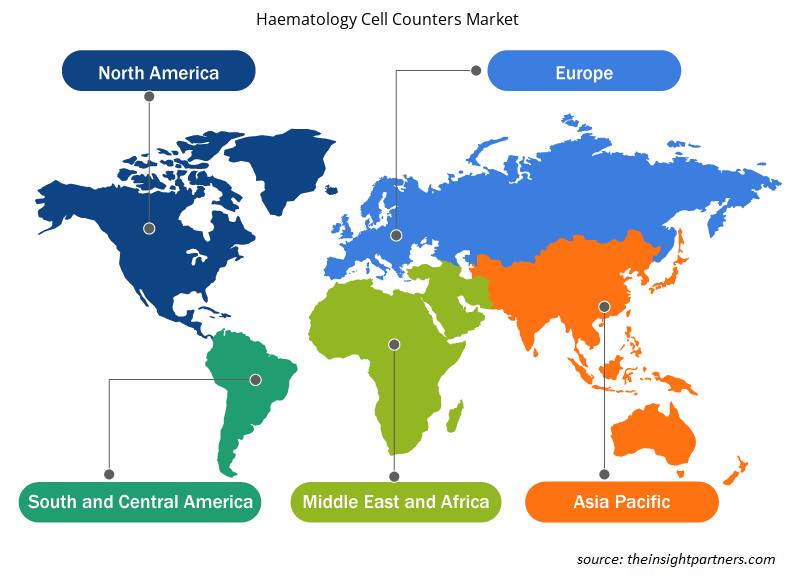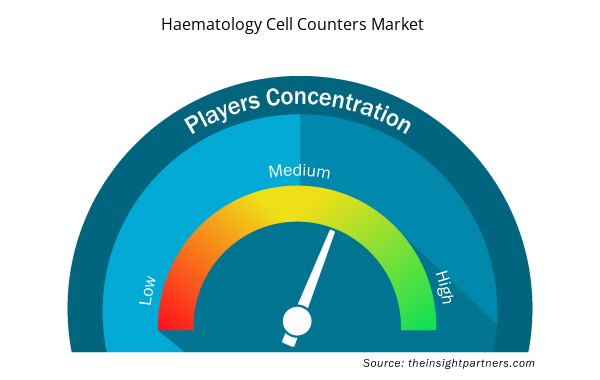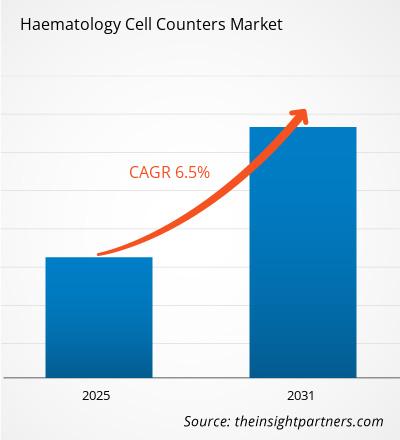The Haematology Cell Counters Market is expected to register a CAGR of 6.5% from 2025 to 2031, with a market size expanding from US$ XX million in 2024 to US$ XX Million by 2031.
The report is segmented by Type (Automatic Hematology Analyzers, Semiautomatic Hematology Analyzers). The report further presents analysis based on Application (Clinical Diagnostics, Research Applications). The report is further segmented based on End User (Hospitals, Research and Academic Laboratories, Others). The global analysis is further broken-down at regional level and major countries. The report offers the value in USD for the above analysis and segments.
Purpose of the Report
The report Haematology Cell Counters Market by The Insight Partners aims to describe the present landscape and future growth, top driving factors, challenges, and opportunities. This will provide insights to various business stakeholders, such as:
- Technology Providers/Manufacturers: To understand the evolving market dynamics and know the potential growth opportunities, enabling them to make informed strategic decisions.
- Investors: To conduct a comprehensive trend analysis regarding the market growth rate, market financial projections, and opportunities that exist across the value chain.
- Regulatory bodies: To regulate policies and police activities in the market with the aim of minimizing abuse, preserving investor trust and confidence, and upholding the integrity and stability of the market.
Haematology Cell Counters Market Segmentation
Type
- Automatic Hematology Analyzers
- Semiautomatic Hematology Analyzers
Application
- Clinical Diagnostics
- Research Applications
End User
- Hospitals
- Research and Academic Laboratories
- Others
Geography
- North America
- Europe
- Asia-Pacific
- South and Central America
- Middle East and Africa
Customize This Report To Suit Your Requirement
You will get customization on any report - free of charge - including parts of this report, or country-level analysis, Excel Data pack, as well as avail great offers and discounts for start-ups & universities
Haematology Cell Counters Market: Strategic Insights

- Get Top Key Market Trends of this report.This FREE sample will include data analysis, ranging from market trends to estimates and forecasts.
Haematology Cell Counters Market Growth Drivers
- Rising Prevalence of Blood Diseases: The high prevalence of blood diseases such as anemia, leukemia, and other hematological diseases is the main driving force for this hematology cell counters market. Healthcare providers heavily rely on current and latest cell counters with increasing numbers of patients who require proper diagnosis that necessitates efficient treatment and management, therefore driving the market.
- Technological Advancements: Advancements in the technology of hematology cell counters form a key driving force in the market. For instance, improvements in automated counting, increased accuracy, as well as ease of user interface lead to enhanced blood analysis efficiency. These products not only make the laboratory work easier but are also contributing to better patient results; hence health institutions are installing more of them.
- Increasing Demand for Point-of-Care Testing: The expanding application base of point-of-care testing (POCT) fuels the demand for cell counters for hematology. Consumer preference for quick diagnosis capabilities in healthcare delivery will see providers turning towards portable and user-friendly cell counters for immediate attention through timely intervention and better patient management in geographies.
Haematology Cell Counters Market Future Trends
- Miniaturization and Portability: Hematology cell counters are miniaturized and portable. Compact, user-friendly devices allow for point-of-care settings or direct testing in remote areas on the spot. This shift increases access to diagnostics, improves speed to decision, and ultimately, patient care.
- Emphasis on Workflow Automation: This is changing the hematology cell counters market because of the greater importance of automation in the workflow of the laboratory. Automated systems cut down human errors and provide better throughput that allows a lab to process samples more efficiently. In this trend of automated systems, laboratories are leaning toward extensive usage of advanced analyzers for hematology that easily accept automation.
- Emphasis on Multi-Parameter Analyzers: With demand for multi-parameter hematology analyzers coming out from the need for comprehensive blood analysis in one test, it represents a great step forward toward workflow automation. Such sophisticated instruments help improve workflows because they give more than one result, such as cell counts and morphology assessment, all at once. This progresses to more efficient laboratory operations and better diagnostics among healthcare providers.
Haematology Cell Counters Market Opportunities
- Health Awareness and Preventive Care Worldwide: Rising health awareness and greater emphasis on preventive care are driving the market for hematology cell counters. Individuals have been adopting various measures to improve their health, and resultant routine blood tests have been on the rise. With respect to this trend, it has become challenging for the healthcare facility to stay up in the game by keeping up with the advance hematology equipment.
- Partnering with Telehealth Services: Major innovation for hematology cell counter makers and telehealth service providers would result from collaboration on remote diagnostics. The use of hematology analyzers would be the way healthcare practitioners could conduct remote consultations while monitoring patient health status by integrating these analyzers with telehealth platforms. This synergy could increase access to diagnostic services, especially in underprivileged rural areas, leading to better care of patients.
- Increased Research and Development Focus: With an increase in the emphasis on developing products in hematology, there is scope for innovation in cell counters. As better biotechnology and automation cut through, more complex devices can be manufactured to yield better accuracy and functionality. The trend makes easy investments in R&D, contributing to differentiation in the market.
Haematology Cell Counters Market Regional Insights
The regional trends and factors influencing the Haematology Cell Counters Market throughout the forecast period have been thoroughly explained by the analysts at Insight Partners. This section also discusses Haematology Cell Counters Market segments and geography across North America, Europe, Asia Pacific, Middle East and Africa, and South and Central America.

- Get the Regional Specific Data for Haematology Cell Counters Market
Haematology Cell Counters Market Report Scope
| Report Attribute | Details |
|---|---|
| Market size in 2024 | US$ XX million |
| Market Size by 2031 | US$ XX Million |
| Global CAGR (2025 - 2031) | 6.5% |
| Historical Data | 2021-2023 |
| Forecast period | 2025-2031 |
| Segments Covered |
By Type
|
| Regions and Countries Covered | North America
|
| Market leaders and key company profiles |
Haematology Cell Counters Market Players Density: Understanding Its Impact on Business Dynamics
The Haematology Cell Counters Market market is growing rapidly, driven by increasing end-user demand due to factors such as evolving consumer preferences, technological advancements, and greater awareness of the product's benefits. As demand rises, businesses are expanding their offerings, innovating to meet consumer needs, and capitalizing on emerging trends, which further fuels market growth.
Market players density refers to the distribution of firms or companies operating within a particular market or industry. It indicates how many competitors (market players) are present in a given market space relative to its size or total market value.
Major Companies operating in the Haematology Cell Counters Market are:
- Sysmex
- Abbott
- Danaher Corporation (Beckman Coulter, Inc.)
- Siemens AG (Siemens Healthcare GmbH)
- Bio-Rad Laboratories, Inc.
Disclaimer: The companies listed above are not ranked in any particular order.

- Get the Haematology Cell Counters Market top key players overview
Key Selling Points
- Comprehensive Coverage: The report comprehensively covers the analysis of products, services, types, and end users of the Haematology Cell Counters Market, providing a holistic landscape.
- Expert Analysis: The report is compiled based on the in-depth understanding of industry experts and analysts.
- Up-to-date Information: The report assures business relevance due to its coverage of recent information and data trends.
- Customization Options: This report can be customized to cater to specific client requirements and suit the business strategies aptly.
The research report on the Haematology Cell Counters Market can, therefore, help spearhead the trail of decoding and understanding the industry scenario and growth prospects. Although there can be a few valid concerns, the overall benefits of this report tend to outweigh the disadvantages.
- Historical Analysis (2 Years), Base Year, Forecast (7 Years) with CAGR
- PEST and SWOT Analysis
- Market Size Value / Volume - Global, Regional, Country
- Industry and Competitive Landscape
- Excel Dataset


- Architecture Software Market
- HVAC Sensors Market
- Biopharmaceutical Contract Manufacturing Market
- Medical Enzyme Technology Market
- Environmental Consulting Service Market
- Wire Harness Market
- Fertilizer Additives Market
- Sports Technology Market
- Health Economics and Outcome Research (HEOR) Services Market
- Vision Guided Robotics Software Market

Report Coverage
Revenue forecast, Company Analysis, Industry landscape, Growth factors, and Trends

Segment Covered
This text is related
to segments covered.

Regional Scope
North America, Europe, Asia Pacific, Middle East & Africa, South & Central America

Country Scope
This text is related
to country scope.
Frequently Asked Questions
The major factors driving the haematology cell counters market are:
1. Rising Prevalence of Blood Diseases.
2. Increasing Demand for Point-of-Care Testing.
North America region accounts for highest revenue share in haematology cell counters market.
Asia Pacific is estimated to grow at the highest CAGR over the forecast period (2023 - 2031).
The haematology cell counters market is expected to grow at a CAGR of 6.5%.
The final report will duly include market size and projection estimates for all the segments from 2021 to 2031, along with a revenue share and compound annual growth rate (%) for the regional/country-wise market wherein 2021-2022 are the historic years, 2023 is considered to be the base year, and the forecast will be provided till 2031, along with CAGR (%).
Sysmex, Danaher Corporation (Beckman Coulter, Inc.), and Siemens Healthcare GmbH are the major companies operating in the haematology cell counters market.
Trends and growth analysis reports related to Life Sciences : READ MORE..
1. Sysmex
2. Abbott
3. Danaher Corporation (Beckman Coulter, Inc.)
4. Siemens AG (Siemens Healthcare GmbH)
5. Bio-Rad Laboratories, Inc.
6. Shenzhen Mindray Bio-Medical Electronics Co., Ltd.
7. Nihon Kohden Corporation
8. HORIBA, Ltd
9. F. Hoffmann-La Roche Ltd
10. Hycel Medical

 Get Free Sample For
Get Free Sample For